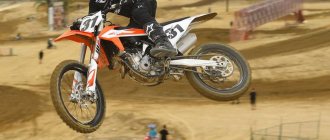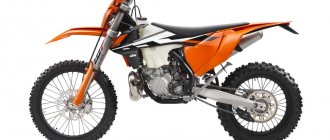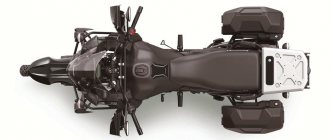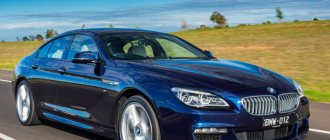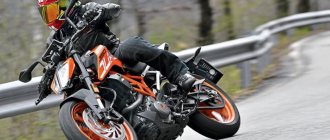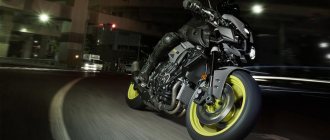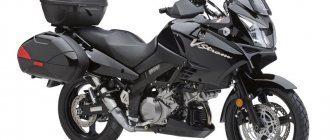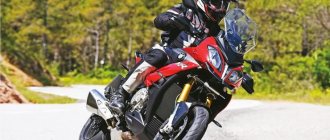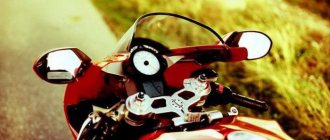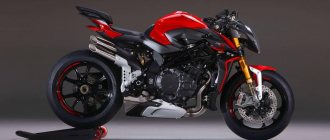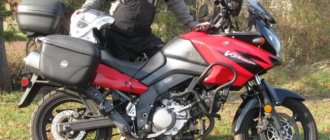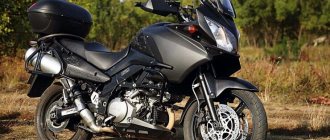Recall of the BMW S1000RR motorcycle
Over 12 years of various rides I reached 1000 cc.
At the beginning of April 2015, I purchased a BMW S1000r streetfighter, which impressed me with its high power, engine modes, design and ABS. I drove it for 3,500 km, so I decided to share my impressions. This is one of the fastest straights. There's always someone on the street asking questions. It steers easily, like a bicycle. Playful and comfortable, not twitchy, as some say. Suitable for a city with traffic jams. Due to the wide handlebar, at first I found the landing uncomfortable. Then I found the right position. It takes turns equally well with or without a passenger.
The brakes are excellent, as reviews from forums about the BMW s1000r have repeatedly stated. Water cooling allows you to stand in a hot traffic jam for several minutes, and the temperature only gets up to 100 degrees, where the fan turns on. Several times there were problems with the manual transmission - I caught neutral. I only got the hang of it towards the end of the season, perhaps there was something wrong with the settings.
At the maximum speed, this bike makes many of its classmates. Only the Kawasaki Z1000 left me, but then one situation got in the way.
BMW is technically excellent. But I will note one minus of my BMW with 1000 rubles - the steering angle is too small for the street and the design is unsuccessful. It lacks some 9 degrees to become an ideal city motorcycle. Another minor drawback is that the wing needs to be larger for our conditions, otherwise the radiator can be washed after rain. By the way, its modern electronics allow it to drive on wet roads and tear up rows. In the rain it drives like it's on dry asphalt. The main thing is not to fly through puddles; there are no electronics against hydroplaning.
The “rain” mode, identical to the car “eco” mode, is just a vegetable. The headlight is excellent, works well even in thick fog.
Overall, I am more than satisfied with the BMW S1000RR Maximum emotions, German quality, confident dynamics and respect on the road.
Hi all! I’m not a fan of writing reviews, but there aren’t many of them about this motorcycle, so I want to share my impressions. I want to say right away that I made the choice in favor of this model by accident. This happened because I had a buyer for my former Yamaha super tenere motorcycle. They offered me good money, and I decided, why don’t I try another motorcycle, since I was already tired of the pimp. As usual, I sat down on the Internet and started digging, and considered either sports or naked. The reason for this choice was that I had been riding endura bikes for quite a long time. Why not try, I persuaded myself, I’ll go for a ride, I’ll sell it when I get tired. And then it started: Yamaha R1 (YZF-R1) , Honda CBR1000RR , Suzuki GSX-R 1000 and, Kawasaki ZX-10R , the choice was quite large. Before that, I managed to ride almost all the flagship sports of the Japanese four; at first I didn’t consider Europe. However, I was always confused by the fit on clip-ons, so I also looked at naked ones. In general, skipping the details of sleepless nights and the agony of choice, I found this handsome man. Now to the point. I took it at that time with scanty mileage, in general it only passed the first one. From the place of purchase I drove under my own power to the house, which was almost 600 kilometers. On the way, I immediately had a great opportunity to get acquainted with the motorcycle. The first impression is traction, traction is not in all gears, I want to pay special attention to the Brembo brakes, they brake really well, the special BMW abs race system, in normal road mode, does not allow the wheels to come off under any circumstances. Also, when braking with the front brake, the system automatically brakes with the rear, although who would be surprised by this now. I really liked the way the track control works. When I got caught in a heavy downpour, I switched to Rain mode, no matter how much I twist the throttle or brake, the systems simply work with fantastic anticipation. Even in comparison with the pimp, which also had a track tire, it allowed the rear wheel to slip, after which it choked the engine, then it slipped again and immediately choked, resulting in some kind of jerking, which by the way contributed to the loss of engagement of the rear wheel. Well, okay, this is an endurik, what can we take from it, and it’s generally not correct to compare these motorcycles. The track tire allows you to gain speed without slipping, even on marking lines and bitumen strips. I can say the same about abs, everything is just perfect. Although when at the junction the motorcycle comes off with two wheels, the abs immediately strangles the engine for literally a second, when the bike has stabilized, you can drive on. By the way, the motorcycle also has an antiwheelie system, which works in conjunction with abs. So, when accelerating, sometimes the connection with the steering wheel is lost, because the front wheel is simply flying in the air, in this case the system allows the front wheel to rise to a certain degree, only after that the electronic limiter is triggered, and the bike does not fall from the wheelie, but smoothly lowers. I would also like to note the simply impeccable work of the quickshifter; by the way, it only works up. You literally just need to touch the gear shift paw, and the gear immediately changes easily and quickly. In general, acceleration turns out like on a CVT, you open the gas and just push the gears. By the way, the gas handle is electronic and does not have any cables, which is also convenient. The gas is dosed clearly and clearly; the handle has no free play at all, unlike many Japanese ones. About engine operating modes. This motorcycle is equipped with 4 engine operating modes: Rain, Road, Dynamic, Dynamic pro. In mode 1, the engine produces only 130 forces, the systems work in such a way as to prevent you from falling under any circumstances. Mode 2 is normal, the default suspension stiffness is in the software, all systems operate as normal. Mode 3 is dynamic, the default suspension stiffness is hard, abs allows you to play around with the rear wheel, it doesn’t completely lock, but it slips. And 4 racing mode, for use on the track, hard suspension, allows you to play around with wheelies, abs works only in the most extreme cases, the rear wheel allows you to skid. (This mode is not suitable for use in the city, except for cases when a little rebel awakens in you) If a big rebel awakens in you, then feel free to press the track tire button and turn it off; by pressing the same button for a longer time, also turn off abs, and before!, horrify the local villagers))) There are also a few other goodies on the motorcycle that are worth mentioning, this is a slipper clutch, cruise control and of course heated grips. I forgot about 3 suspension settings modes, soft, normal and hard. So I’ll tell you about them separately. I always drive in soft mode because it is the most adequate mode. It is basically impossible to drive in hard mode. The normal mode is a little different from the hard mode and a little different from the soft mode, but I don’t know why. For example, for me, all these modes are divided not into: soft, normal, hard, but into: slightly hard, medium hard and damn hard. In short, BMW in its usual role, this company has some special reverence for unrealistically stiff suspensions. It’s a pleasure to drive on an ordinary good road, but as soon as you drive onto a bad road, you start to shake out like a pissing rag. I understand, of course, that I want a lot from a motorcycle that is based on a super sport, but my opinion is that the stiffness of the suspension is simply too much.
Regarding the landing. Despite the presence of a steering wheel, the seating position is closer to a sports one, that is, you still sit in the same familiar shrimp position, only this time it’s a royal one. Although it’s not all that bad, 600 km in one day, to be honest, I’m not very tired. There is no wind protection, at 150 you already have to lie down on the tank, or it will blow away. At 260 km/h, which by the way is the maximum speed for this motorcycle, you feel like a silver surfer rushing through hyperspace at the speed of light, steering the stars. Or, in simple terms, your head is torn off with such force that after a minute of driving at that speed, your entire cervical spine hurts. Regarding acceleration, it shoots like a cannonball; compared to its older brother, it has a less powerful and revving engine, but the torque is still the same 112 Newtons, which is achieved at lower speeds than on the RR. This allows you to dash around the city and overtake on the highway in a matter of seconds. Of the minuses. Despite the presence of a steering wheel, the turning angles remained sporty, and therefore the turning radius is huge. By the way, there is still enough space from the steering wheel to the tank, I don’t understand why they didn’t remove the limiters. When accelerating sharply, it most often causes a wobble. There is a standard damper, but it does not work well enough. The oil radiator is located low, and damn it, they could have come up with a mesh at the factory, but no, you have to order it from the Chinese. The design is unsurpassed, from the side and back, I try not to look at it from the front, it’s disgusting, kind of cross-eyed. Although some people like it. Damn stiff suspension.
Go to the BMW S1000RR
Check out the test drives:
- BMW S1000RR (2010): test drive from Moto Racing magazine
- BMW S1000RR (2015): test drive from Popular Motors magazine
- BMW S1000RR (2012): test drive and differences from the 1st generation
Comparison test: Aprilia Tuono, BMW S 1000 R or Yamaha MT-10 SP?
Each of them is real evil, a bundle of the latest achievements compressed into metal and plastic. Behind each are the naked ambitions of their creators - to be the fastest, lightest, most maneuverable, beautiful, and technologically advanced. Uncompromising naked bikes: Aprilia Tuono V4 1100 RR, Yamaha MT-10 SP and BMW S 1000 R. Moreover, the original superbikes, the parents of these three motorcycles, have completely different characters. How hereditary is it?
The Aprilia is unashamedly beautiful - it's not for nothing that it carries the genes of WSBK and MotoGP racing motorcycles. Compared to the Tuono, the Yamaha MT-10 SP, which looks like a large transforming robot from Japanese anime cartoons, and especially the BMW S 1000 R, pale in comparison. When this model was just starting to be developed in 2011, sketches by BMW designers - among whom, by the way, were our compatriot Evgeny Zhukov - looked bright and futuristic. But something went wrong, and the production motorcycle with the strange signature squint of asymmetrical head optics looks like a kind of askew Bavarian villager.
Aprilia Tuono V4 1100RR
The most evil of the engines in our trio is again the Tuono. After all, this engineering masterpiece V4 with a cylinder angle of 65 degrees is related to racing engines from the royal MotoGP class! BMW and Yamaha engines quote their respective sportbikes, that is, the BMW S 1000 RR and Yamaha YZF-R1. Of course, the engineers have noticeably revised the hardware of all three motorcycles: the engines have been significantly derated, and the power delivery characteristics have been smoothed out.
The electronic worm of the Tuono tachometer is unreadable, the inscription on the panel announces the motorcycle’s reluctance to work. At some point the error went away on its own, but a residue remained...
But the difference remained the same as between sportbikes!
Aprilia is the most uncompromising option. The character of the engine is explosive: crazy pickup after 8000 rpm! The gears are the most stretched, the quickshifter only works fully in the racing format. Everything here is subordinated to two gods - beauty and speed, and the rest is secondary. The suspension has a “Track Only” sticker, so the Tuono owner should forget the word “comfort”. Or turn your attention to other brands. For example, on the BMW S 1000 R, which is noticeably more convenient for everyday use. The engine does not tire you with its endless expression, although there is a lot of traction always and everywhere, and the quickshifter in its work can become a model for others. The seating position and ergonomics do not require you to have sporty flexibility; heated steering wheel grips are prohibitively sybaritic for this class. The duet of engine and chassis does not give a single reason for criticism. In the Comfort suspension position, the ride quality is acceptable by class standards, and the brakes are the best of the trio!
The left Tuono remote control is frankly overloaded, and controlling the functions is the most difficult of the trio and requires some getting used to
But the steering angle is frankly small for the city crowd. And while this was appropriate for its progenitor, the BMW S 1000 RR sportbike, here it is no longer appropriate.
Yamaha is the most comfortable. The ergonomics of the pilot are closer to the classic road landing position, the engine is calmingly friendly, the chassis swallows all road debris in a comfortable mode, and the funny mask on the headlight works surprisingly well as a fairing. The irregular alternation of flashes when the engine is running gives the engine a unique exhaust sound and gives it a little V-twin character. In the lower and middle speed ranges, the power unit here is so elastic that you can simply forget about gear changes in the city. The MT is quite suitable for travel, as evidenced by the tourist (!) accessories offered by the factory - soft side cases and a high windshield. The result is almost a Tracer crossover, only on anabolic steroids.
The passenger seat is the same as in the MT-10 SP, but, being unoccupied, looks much more aesthetically pleasing
What if you go to the track?
The Moscow Raceway track is like a litmus test: it is immediately clear who is the “real athlete” here, and who is just mimicking him, hiding behind electronics and sporty design. Aprilia was faster everywhere: on the switchbacks, on the exits of the corners. On long arcs it seems that the motorcycle was simply glued to the canvas, and on the return straight the speedometer rested on the 274 km/h electronic limiter (the true speed at this moment was 262.1 km/h). In the technical and difficult section of the MRW, it was the Aprilia that always left the aftertaste of yet another unfinished turn: it seemed like you braked extremely late, and the lean angle was critical, but it turns out that you again underestimated the limits of the chassis! Remember the driving style of the crazy Massimiliano Biaggi, who brought the Aprilia factory team two championship titles in the world superbike? In many ways, it is he who should be thanked for such sharp adjustments to the motorcycle.
The full version is available only to subscribersSubscribe now
I'm already subscribed
Comfortable naked BMW S1000R
The BMW S1000R road motorcycle first went on sale in 2014. And in 2021, the model was restyled. Then the manufacturer presented an updated version of the naked motorcycle. Were changed:
- Appearance. The general features of the motorcycle have changed. The manufacturer also took care of new streamlined plastic panels. The instrument panel was replaced with a more advanced one. The steering wheel was taken from the 3rd generation 1000RR model. A new titanium exhaust pipe has been installed.
- Internal components. The engine, chassis and steering have undergone changes. The braking system has become more responsive. The weight of the motorcycle decreased to 205 kg, and the engine power reached 165 hp.
- Technological part. With the new steering wheel, vibrations that were transmitted from the body and motor disappeared. The model is equipped with an ABS Pro system, the ability to increase and decrease gears without a clutch.
Users liked the restyling. The motorcycle has become more comfortable, and the updates significantly exceed the functionality of the model’s direct competitors.
BMW has always been an example for many global brands that produce modern motorcycles. That is why many pay attention to technological equipment and electronic parts. The motorcycle is equipped with all kinds of electronics:
- Anti-slip system.
- Innovative ABS Pro is responsible for braking.
- HP Gearshift Assistant Pro on the gearbox.
- DTC and DDC systems.
- Cruise control, etc.
The flagship model S1000R of the second generation is in no way inferior in technological equipment to its direct competitor - the BMW S1000RR. Although it is almost impossible to compare these models, many users talk about the internal competition between the two bikes.
Tuning and repair of BMW S1000R
Motorcyclists speak flatteringly about the possibility of upgrading their “iron horse”. Although BMW has always presented a wide range of tuning parts, owners note the special style and quality of Rizoma brand parts. The Italians have caught the fine line between madness and grace, which has made them popular in the international market. By the way, it is the Italian manufacturer that supplies the most popular spare parts for modernization and tuning, covering the entire market.
The main advantage of the motorcycle is its technological equipment. On thematic forums, users repeatedly admire the ease of control, because a lot of electronics make driving much easier. This advantage can also be attributed to the significant “disadvantages” of the model, because similarly with the BMW 1000RR, self-repair is out of the question. Although the manufacturer supplies original parts to the domestic market, components can only be replaced at a service center.
Reviews from real BMW S1000R users
There is not a single doubt that it was the BMW RR series that has become the star of recent years and the sales leader, but discussions of the model range, comparison of advantages and disadvantages, comments on the changes to the S1000 are very easy to find. Owners share their operating experience, noting the electronic component of their bikes. There are practically no downsides, because the motorcycle is quite powerful and comfortable, and the handling is in the best traditions of BMW. To gain the most accurate understanding of how much the S1000R model was loved by users and showed excellent performance in operation, it is enough to remember that this is one of the few road motorcycles that was paid attention to in the Top Gear program.
Technical characteristics of the BMW S1000R
Back in 2013, when developing the model, they took the earlier model range of BMW 1000RR motorcycles as a basis. It was on the basis of its frame that the new product was designed. It is worth noting that in 2021 the updates were made taking into account the upgrade of the third generation 1000RR, and many of the “conveniences” for the driver were simply copied. At the same time, the technical characteristics of the motorcycle remain at their best:
- Engine power is slightly below 1 m3.
- 4 valve cylinders.
- Six-speed transmission with new HP Gearshift Assistant Pro.
- Fuel consumption is 5.4-5.6 l/100 km.
- Increased wheelbase (compared to the 2014 model) - 1439 mm.
- 17" wheels with standard tire profile.
- The disc brake system consists of three discs (2 front and 1 rear), operating on a five-piston caliper. Timely and rapid braking is regulated by the latest generation of the electronic ABS Pro system.
Kawasaki Z1000 VS BMW S1000R – COMPARISON
The killers
Kawasaki Z1000 2014, 1043 cm3, 142 l. s., 220/221* kg (*curb weight for version with ABS), 230 km/h, RUB 589,800. (RUB 610,500 with ABS) BMW S1000R 2014, 999 cm3, 160 l. s., 207 kg (curb weight), 250 km/h, from RUB 695,000.
text: Vladimir Zdorov photo: Evgeny Bobrikov, Nikita Kolobanov
in the photo: Vladimir Zdorov, Stepan Berestov
“In the heavy asthmatic wheezes of a metropolis suffocating with millions of cars, unattainable motorcyclists slip through as bright sparks of unfulfilled hopes of motorists who died in eternal traffic jams . Among this stream there are their own narrowly oriented specialists, originally created to break up space and densely compressed city traffic - naked bikes. Fierce versions of sportbikes and simply independent models, practically in no way inferior in power to their “plastic” counterparts - these factory aggressors have the same philosophy, but a different engineering approach to creation... We are talking about the BMW S1000R and Kawasaki Z1000.
Starting point The history of the appearance of today's counterparts is seriously different: if the Kawasaki Z1000 stretches its pedigree back to the time of the existence of dinosaurs, and with some desire it is quite possible to include the legendary KZ1000 from the cult film Mad Max among its “relatives,” then the BMW S1000R is the direct heir to one of the best today's sportbike moment, the S1000RR. Accordingly, in the case of the “Japanese” we see another interpretation of what was originally a city car, while the “German” in many respects, both in essence and in content, is a stripped-down sportbike. Formally, these cars are separated by a little less than 20 liters. p., but these are purely paper calculations - in reality there are two completely different religions and their own values. The eternal philosophical question about the primacy of spirit or matter in our comparison will be interpreted into the dilemma of form and content. The Kawasaki Z1000 has not been deprived of the attention of designers before, but in its latest iteration it has turned into a ferocious predator tearing into pieces any living flesh around itself, gloomily looking at the world with squinted LED head optics. It is important that the creative solutions of the design team were not limited to this: the appearance of the car is harmonious from any angle - be it the complex shapes of the dual mufflers or the “hump” of the gas tank that is successfully integrated into the overall stylistic image. Absolutely everything is in the “topic”, even minor details, from rear-view mirrors to the brake light.
With BMW, the situation does not look so harmonious: it is clear that the company with the BMW S1000RR did not just remove the plastic, simultaneously removing one letter in the name. It’s obvious that they worked with the ergonomics of the pilot’s seat and with the general style, but something went wrong... The front part of the motorcycle gives me a persistent déjà vu: having once again introduced my Suzuki TL1000R to asphalt in the now mesozoic year of 2002, I, I remember, with the help of hundreds of dollars and a couple of hours of time, I built a much more evil and memorable naked bike than the Germans were able to create with the help of a whole staff of slackers in 2013. Fortunately, this is the only serious problem of the BMW S1000R: apart from some rough edges, which are discussed below, today the descendants of the blond Aryans have in their arsenal one of the most powerful and interesting naked cars - more precisely, according to the classification of their pedantic German neighbor, the roadster. Yes, it’s a little “skewy” (if it hurts someone’s ears, then it’s “traditionally asymmetrical”), like its parent, but a very evil device, stuffed with much more electronics than the most kosher mincemeat with apples. Against the backdrop of the Bavarian Kawasaki Z1000, which is stuffed with microcircuits all the way to Munich, it looks like a lonely refugee: there is nothing to count on here except ABS. By the way, specifically in our case there was a “naked” version, where in place of the ABS “comb” there was a fluorescent inscription “We save money and focus on safety - always yours, Kawasaki team.” In my opinion, buying such powerful and expensive motorcycles today, while winning about 20,000 rubles (especially against the backdrop of the total cost of the device) that they ask for ABS, is short-sighted, to say the least...
Summarizing such extremely dubious categories as style, design and the general perception of designers' ideas, let me slide into the dark Valhalla of subjectivity: the Kawasaki Z1000 is a complete image of a stylish, “evil” naked bike, the only complaint about which can be put forward is only the premise that it is not yet from you, but from someone else. In the case of the opponent, the situation seems to have been as follows: the BMW S1000R was in the rough hands of the descendants of the Teutons, who, due to some misunderstanding, were responsible for the design of the project. Here they chopped it off, there they threw in some hard German techno (no less than Rammstein), and here... well, what is it here, apparently the designer simply did not show up for work, so the welder finished the project. Robot welder, because this process on any European, Japanese and other conveyors (with the exception of which ones is clear) has long been left to soulless automata.
Sublimation Everything that the BMW S1000R did not achieve in the “true Aryan” category, the motorcycle makes up for in technical terms. Despite the relatively small difference in power with its counterpart, in practice the BMW is more powerful, “meaner” in any engine operating mode starting from 5000 rpm. Its sportbike pedigree suggests a very precise, “collected” behavior of the device on the track, almost comparable to its “parent”, which has long and firmly occupied one of the prize places in the cohort of the best sportbikes on the planet. Of course, even in a kilogram of selected apples there will always be a couple with worms. In the case of the BMW S1000R, such a “worm” is the dimensionless “stick” of the steering wheel, which in a past life was obviously a barbell. Such a “crossbar” can hold down more than one hundred special forces soldiers, and for the pilot this means guaranteed inconvenience in “tight” traffic jams and understanding glances from the owners of heavy cruisers. Otherwise, everything is in order with the ergonomics of the BMW S1000R... but only until you find yourself behind the wheel of the Kawasaki Z1000, a motorcycle that is initially a little more compact and professes its own values. Here it is more appropriate to say that you are sitting “in a motorcycle,” although at first there is a feeling of some understatement and misunderstanding: the steering wheel on the Z1000 is noticeably closer to the pilot, the classic triangle “pegs, seat, handlebar” is not as “scattered” as on the BMW , which ultimately gives such assembled ergonomics. It is curious that in terms of comfort, this arrangement in no way pinches even a tall driver - the Kawasaki footpegs are far from the sportbike extremism of the BMW, which adds comfort, but, accordingly, reduces the ground clearance in slopes and significantly limits the possible use of the Japanese naked bike on tracks. However, I would not talk about this as a serious drawback: initially, the habitat of such cars was the city, to a lesser extent, small trips, and in very rare cases, race tracks. From the point of view of overall comfort and suitability for riding in the city, the Kawasaki Z1000 looks preferable to its opponent.
The “Japanese” engine is noticeably richer at low and medium speeds, the motorcycle itself is, albeit a little, more compact, especially with regard to such a critical value for dense traffic as the overall overall width. For advanced wheelie lovers, Kawasaki also looks preferable to the “German”. Both bikes are so powerful that they can lift the front wheel into the air even in third gear, but this will require very specific skills and effort at the level of a professional stunt rider. Therefore, the working, that is, the basis, transmission for wheelie in both cases should be considered the second. But here, too, there are some nuances: let’s say, on the Z1000, the speed range for confidently lifting the front wheel into the air starts at 40 km/h, while the BMW speedometer must “draw” at least 70 km/h, which logically fits into the picture of power settings, which the dynamometer showed us. The BMW S1000R, even despite the “castration” carried out, still has very strong sportbike roots of its “parent” - in other words, the engine needs to be turned.
In principle, there is nothing wrong with this, but the characteristics of the Kawasaki Z1000 engine, where the “meat” is served right here and immediately at the “bottoms,” are preferable for the city. From the point of view of comfort, the situation is as follows: Kawasaki is not as “die-hard” as BMW, its suspension is a little more willing to “eat up” minor road troubles, but everything is within the bounds of decency - the motorcycle is very “assembled” and allows for as aggressive piloting as you like. On the track, the natural limiter will be the driver’s footpegs, and in the case of an advanced rider, the muffler linings and the “heel” of the side stand. As for aerodynamics, a naked bike by definition lacks it, but the Z1000 is slightly inferior to the BMW in this category - this is a consequence of the low-mounted headlight. The S1000R has several optional windshields, although they disfigure the already dubious front part of the motorcycle, but allow you to feel relatively comfortable even with speedometer readings of 200+. In principle, companies specializing in tuning offer similar solutions for Kawasaki, but here you just need to decide what is more important - style or functionality. The BMW S1000R, despite the complex of measures taken to “humanize” it, is much closer in behavior and comfort to a sports bike than to a city car, which is especially noticeable against the backdrop of the Kawasaki Z1000 exuding peace and tranquility.
The braking potential of both motorcycles has a double reserve for civilian use. Moreover, neither Kawasaki nor BMW give in even with intensive piloting on the track, although there are some nuances here: in this field I would still give a slight advantage to the BMW, especially considering that it has a special racing ABS mode — Kawasaki cannot offer such electronic joys.
Handing Out the Elephants For once, the machines being compared are so different and so far apart in philosophy and design approach that I don't have to throw out various complex sentences and subtle ambiguous definitions trying to find the differences in two standard tablespoons. For those who don’t have an extra 100,000–300,000 rubles, and the word “track” is associated with a musical composition, the Kawasaki Z1000 is perfect. The “Japanese” has everything that is needed for urban use, and even a little more; all claims to the motorcycle are beyond the territory of 220 km/h, that is, already beyond good and evil. The BMW S1000R will definitely not help save your money - the “full stuffing” option will be almost 300,000 more expensive than the Kawasaki... On the other hand, in fact, the BMW S1000R is almost no different from the company’s sportbike, and this naked bike is not suitable for the track. will be much inferior to its “plastic” counterparts. Where Kawasaki has already thrown the green flag, BMW will still accelerate, but all these calculations are relevant exclusively for the track. Whatever device you ultimately choose, it will definitely be worthy. /
